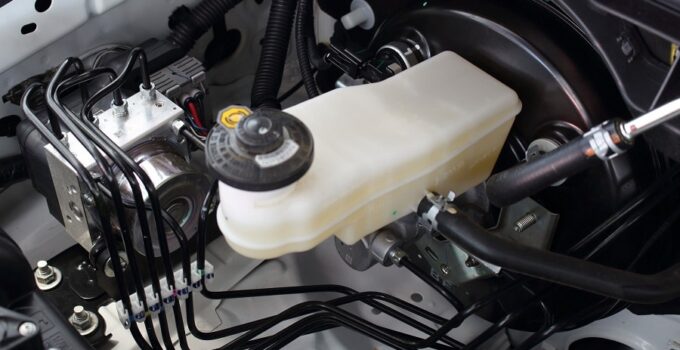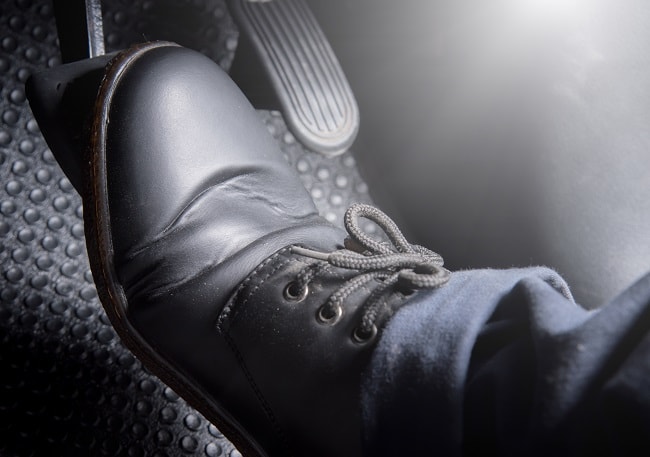
This is one of the most important vehicle safety innovations of the last century SECTION. According to the definition, this abbreviation stands for anti-lock braking system. The vehicle supplier Bosch presented such a system to the public for the first time in 1978. Today it is rightly part of the standard safety equipment of your vehicle.
Contents
What is ABS?
Actually, there is a simple explanation for the purpose of your anti-lock braking system. As the name suggests, its purpose is to stop blocking. The point here is that your wheels should not lock when you brake hard. This always happens when the sliding friction force of your tires on the road surface is less than the braking force applied. Should the wheels lock, then „slip“ these almost over the road surface and the brakes can no longer work properly. Because high temperatures occur in the area of the tire with surface contact, this area can be subject to extreme wear.

How does your ABS work?
In general, tachometers determine the rotational speeds of your vehicle wheels. These values are then passed on to the ABS control unit, which is able to use them to calculate slip and rotational speed. Slippage is „slipping“ of the tire along the road surface. If the system determines that this is increasing significantly, the braking force is stabilized at the current level or even reduced. Conversely, this is also increased again if the slip decreases significantly. This maximizes the braking force transmission in order to be able to brake the vehicle as quickly as possible. The effect that explains your anti-lock braking system corresponds to what is known as stutter braking. This technology was primarily used on slippery roads when no ABS was available as a driver assistance system. The brake pedal was pressed briefly and intensively several times to stop the vehicle quickly, which also prevented the wheels from locking. Today, this technique is rarely taught in driving schools.

What are the advantages of the antiblocking system?
There are a number of positive effects that a functioning ABS can offer you. In addition to the safety aspects already mentioned, there are other positive properties. This also includes reducing your tire wear (see tip). In general, an anti-lock braking system is able to reduce the braking distance you need. This also applies if the driver himself has mastered stutter braking perfectly. However, you should note that braking distances on snow can still be long. Another advantage of your ABS that should not be underestimated is that your wheels continue to have optimal road contact. This allows you to transfer lateral leadership and steering movements even when braking hard. This means that your vehicle will not swerve as quickly and you may even still be able to carry out a successful evasive maneuver.

What are the ABS types?
In principle, a distinction is made between three-channel and four-channel anti-lock braking systems for cars. The first type mentioned is no longer part of the standard repertoire of vehicle manufacturers. With this type of ABS, only the front wheels were controlled individually, while the braking force applied to the rear wheels was regulated together. Today, the four-channel systems are primarily used, since all wheels can really be controlled individually. This also helps to precisely control the braking force, so that the vehicle can also be prevented from skidding or skidding. The fact that your ABS only intervenes when the vehicle speed is more than 6 km/h is also interesting. In addition to the wheel speed sensors, the most important components of your anti-lock braking system include the control unit and the individual wheel brakes and the appropriate cables.

Frequently Asked Questions ( FAQ)
⚠ Why does my brake pedal pulsate when I brake hard with the anti-lock braking system active?
The explanation is how your anti-lock braking system works. As already described, it is important to prevent your wheels from locking up. In doing so, your ABS can temporarily reduce your braking power so that the tires don't just start sliding across the road surface (this is also called slip). For you as a driver, this means that you will feel your brake pedal pulsing when the ABS kicks in. However, you should fully depress your brake pedal to benefit from maximum braking performance.
⚠ Can ABS prevent aquaplaning?
Unfortunately, an anti-lock braking system is not able to prevent what is known as aquaplaning. This effect occurs when there is a lot of water on the road surface. This also causes your tires to slip or slide when the water can no longer be displaced via the tire profile. An ABS cannot prevent the vehicle from skidding during steering movements and can only rarely reduce the braking distance. The reason for this is that the aquaplaning effect occurs even without braking and a reduction in braking force cannot have the desired effect.
⚠ What are the disadvantages of an anti-lock braking system?
Nowadays, the general disadvantages of an ABS are to be regarded as rather minor. While such a system was quite heavy at the beginning (especially in comparison to the total vehicle weight that was usual at the time), it is hardly significant today. Nevertheless, the installation of this safety system has an impact on the vehicle price, although this equipment is mandatory for new vehicles in the EU.
⚠ Can and/or must old vehicle models be retrofitted with an anti-lock braking system?
There is currently no obligation to retrofit so-called existing vehicles. In 2004, however, car manufacturers undertook to install this safety system in all new vehicles.
Conclusion
Safety plays an extremely important role when driving a car. The anti-lock braking system, ABS for short, is particularly important because it reduces the braking distance enormously in dangerous situations. Even if this is only used for about every 50th braking, you should always ensure that it works correctly.
A tip from CarTipsandmore: An ABS system is now a standard vehicle safety system. Its correct function also helps to reduce your tire wear. Because when braking hard without ABS, so-called brake plates quickly form on the tires. If the wheels no longer lock, this is effectively prevented.
